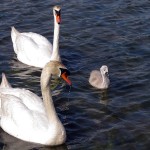Dateline – June 27, 2014
NOTE: This post is part of a continuing series of observations: [ First | << Prev | Next >> ]
Long hot Texas summers can take a toll on ponds and lakes in the Dallas/Fort Worth area. Water that appears clear and pure in the winter and spring can become dirty and smelly under the relentless heat of the summer sun. Even here at Josey Ranch Lake algae blooms pushed by strong winds are forming mats in the shallow water areas. This will likely turn ugly when the heat becomes oppressive later in the summer.
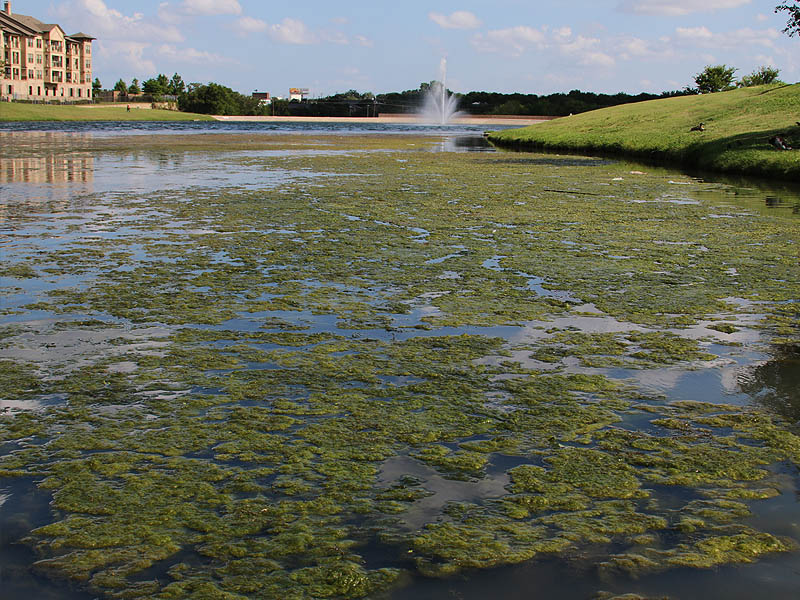
I have been observing this family of Mute Swans for roughly 14 weeks now. I cannot tell you what a pleasure it has been to watch this little cygnet grow over the last several months. The juvenile is right around ten weeks of age now. His feathers are coming in and his appearance changes significantly from week to week. He is nearly as large as his mother now, and seems to be carrying himself with much more confidence of late. It should be very interesting to watch this young bird as he transitions into the fledgling stage of his life in the coming weeks.



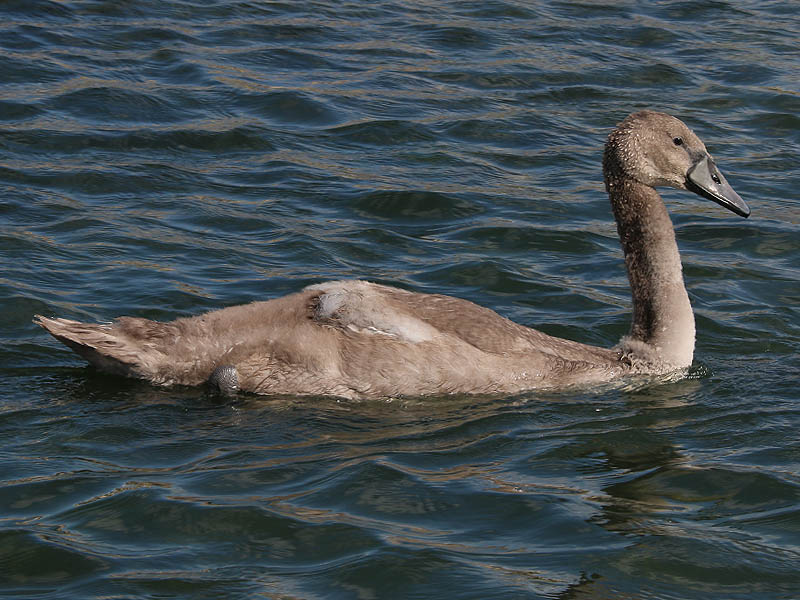





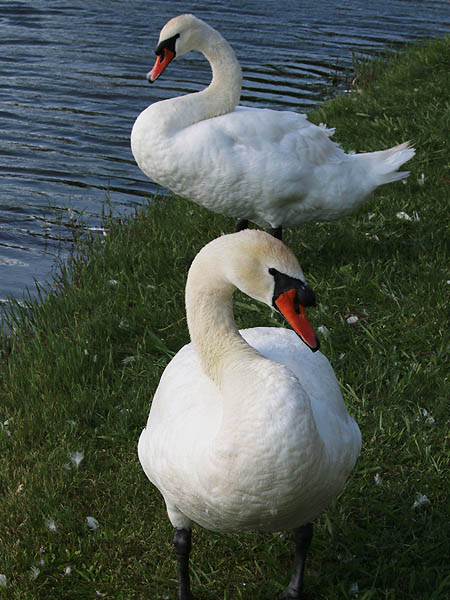


As always there was a variety of other urban wildlife activity at the park on the afternoon I visited. Right away I was greeted by two species of strikingly colored blue birds. I spotted this male Eastern Bluebird as he flew from branch to branch in a group of Mesquite Trees.

Wikipedia states that these birds can sometimes gather into flocks of a hundred or more birds. I have never seen such a thing, but would certainly like to. Here is how Wikipedia describes the life history of the Eastern Bluebird:
Eastern Bluebirds are very social birds. At times, they gather in flocks of a hundred or more. However, they are territorial during the breeding season and may continue to defend a feeding area throughout the winter. Mating occurs in the spring and summer. A mature female typically raises two broods each season. Nests are constructed in trees within abandoned woodpecker holes or other cavities that provide adequate protection (usually several feet above ground). Construction of the nest is done primarily by the female and takes around 10 days to complete. These nests are small, cup-like structures lined with grass, feathers, stems, and hairs. Each female lays three to seven light-blue or, rarely, white eggs. The female incubates the eggs, which hatch after 13 to 16 days. The young cannot care for themselves upon hatching. The female broods the chicks for up to seven days after hatching. Fledglings then leave the nest 15 to 20 days after hatching.
Both parents cooperate in raising the young, which they feed a diet consisting almost entirely of insects. Some young stay around the nest to help raise another brood. Fledglings are grayish in color with speckled breasts. The blue color becomes much more prominent and the speckles on their breasts disappear as they mature. Bluebirds may begin breeding the summer after they are hatched.

Down near the creek I found this other intriguing blue bird—a mischievous Blue Jay making his way through the branches with a prized grasshopper clutched in his beak!

Birds of the heron family were out in force on this afternoon as well. Strong winds made for difficult flying conditions for some of the larger birds like the great Egret pictured below. Launching into a headwind created a moment or two where the big bird was virtually stationary in midair as he worked to build momentum.—a great picture taking opportunity!

The fledgling Green Herons were still out and about this week. Their slightly awkward flying—and even more awkward landings—make them easy to spot as they move from place to place around the lake. The three siblings still follow each other as they move about the park, but they do not remain in such close proximity any longer. Maturation requires that these young birds become independent of each other, as adults they will typically go about their business alone.




Below you will find pictures of a Gizzard Shad spawning congregation. Hundreds of these fish would gather near the banks of the lake. There they would roil the water quite dramatically for several seconds before finally moving on. I observed multiple aggregations form up and then dissolve over the course of my visit.




Wikipedia has this to say about the Gizzard Shad:
The American gizzard shad, Dorosoma cepedianum, is a fish of the herring family Clupeidae native to fresh and salt waters of eastern North America.
Like other gizzard shads, the body is deep somewhat forward of the middle. It is a grayish or silvery blue above, becoming silver on the sides and white below. The dorsal fin has 10-12 rays; in adults, the last ray is very long, extending beyond the rest of the fin. The caudal fin is deeply forked. They can reach a length of 22.5 inches (57 cm), and weigh up to 4.37 lbs (1980 grams). 15% of D. cepedianum breeds in its second year about 59,000 eggs, the rest about 379,000 in its third year.
American gizzard shad begin life feeding on zooplankton, using their teeth to catch them. At about 1 inch in length, they lose the teeth, become deeper-bodied, develop the muscular gizzard, and become filter feeders, consuming both small invertebrates and phytoplankton, as well as some sand for the gizzard.
They live in a variety of open waters, both clear and silty, including rivers, swamps, lakes, and bays, typically near the surface. They avoid fast-moving water, But have been witnessed in large schools near, and under, dams, warm water outlets, and turbine outflows.
Most of the pond’s Mallard ducklings have grown to the point that is becoming difficult to tell from them from the adult birds. Still, some new ducklings are hatching out even at this late date. Below you will find a picture of fledgling Mallards swimming with some adult birds, and another photograph of a mother Mallard with a single, only days old, duckling.
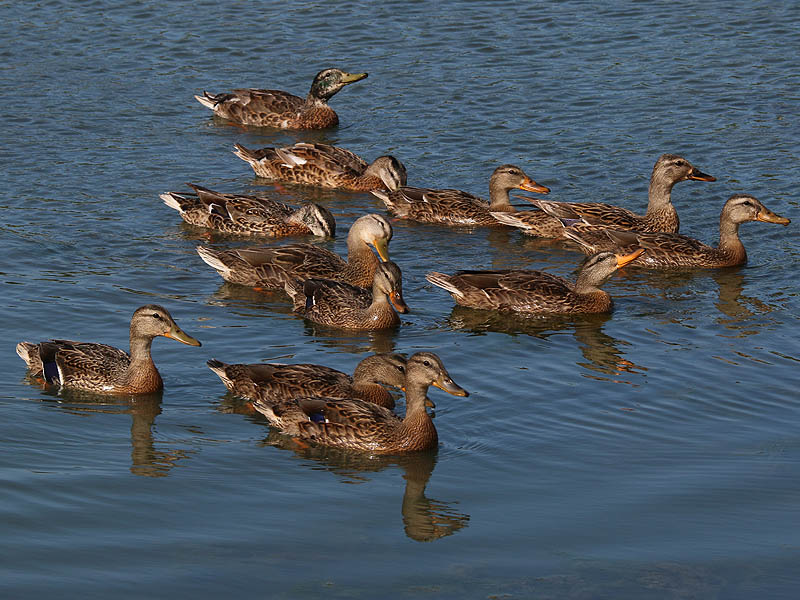

In addition to young birds, there were also many juvenile mammals busying about the park on this sunny afternoon. I was startled to notice a surreptitious young Nutria keeping an eye on me from under the boardwalk. A charming Eastern Cottontail was feeding in the manicured grass nearby.


Later, I found a couple of Fox Squirrels foraging around the Pecan trees near the creek. Fox Squirrels are some of my favorite animals and I always enjoy watching their antics. Here is how Wikipedia describes the behavior of the Fox Squirrel:
Fox squirrels are strictly diurnal, non-territorial, and spend more of their time on the ground than most other tree squirrels. They are still, however, agile climbers. They construct two types of homes called “dreys”, depending on the season. Summer dreys are often little more than platforms of sticks high in the branches of trees, while winter dens are usually hollowed out of tree trunks by a succession of occupants over as many as 30 years. Cohabitation of these dens is not uncommon, particularly among breeding pairs.
They are not particularly gregarious or playful, in fact they have been described as solitary and asocial creatures, coming together only in breeding season. They have a large vocabulary, consisting most notably of an assortment of clucking and chucking sounds, not unlike some “game” birds, and they warn the listening world of approaching threats with distress screams. In the spring and fall, groups of fox squirrels clucking and chucking together can make a small ruckus. They also make high-pitched whines during mating. When threatening another fox squirrel, they will stand upright with their tail over their back and flick it.
They are impressive jumpers, easily spanning fifteen feet in horizontal leaps and free-falling twenty feet or more to a soft landing on a limb or trunk.





Several species of Texas doves were observed at the lake park on this visit as well. Doves do very well in an urban environment, and can become quite abundant in our cities. Represented at the lake on this afternoon were members of three different species: the Rock Dove, the Mourning Dove, and the White-winged Dove. Here is what Wikipedia has to say about the dove family of birds (Columbidae):
Pigeons and doves constitute the bird clade Columbidae, that includes about 310 species. Pigeons are stout-bodied birds with short necks, and have short, slender bills with fleshy ceres. Doves feed on seeds, fruits, and plants. This family occurs worldwide, but the greatest variety is in the Indomalaya and Australasia ecozones.
In general, the terms “dove” and “pigeon” are used somewhat interchangeably. Pigeon derives from the Latin pipio, for a “peeping” chick, while dove is a Germanic word that refers to the bird’s diving flight. In ornithological practice, “dove” tends to be used for smaller species and “pigeon” for larger ones, but this is in no way consistently applied, and historically, the common names for these birds involve a great deal of variation between the terms. The species most commonly referred to as “pigeon” is the feral rock pigeon, common in many cities.
Doves and pigeons build relatively flimsy nests – often using sticks and other debris – which may be placed in trees, ledges, or, on the ground, depending on species. They lay one or two eggs, and both parents care for the young, which leave the nest after seven to 28 days. Unlike most birds, both sexes of doves and pigeons produce “crop milk” to feed to their young, secreted by a sloughing of fluid-filled cells from the lining of the crop. Young doves and pigeons are called “squabs”.





What may be the most interesting observation of the day follows below. Recent rain showers overflowed the spillways of the park’s ponds and carried fish into the outflow creek. When the water receded it left many of these fish stranded in small standalone pools of water. Resident snakes were quick to take advantage of this potential bounty.
Below you will find pictures of several different species of snakes gathering around one of these small pool waiting for their chance to hunt the fish trapped within. A video of some of the hunting behavior is included at the very end. The old saying, “it will be just like shooting fish in a barrel,” naturally comes to mind when witnessing a situation like this one.
Two subspecies of the Plainbelly Water Snake are represented here—the Yellowbelly Water Snake and the Blotched Water Snake. A Western Ribbon Snake made a brief appearance as well. All of these snakes are nonvenomous and are harmless to people.
The fish they are feeding on appear to be sunfish and juveniles of some kind of game fish—possibly Largemouth Bass.
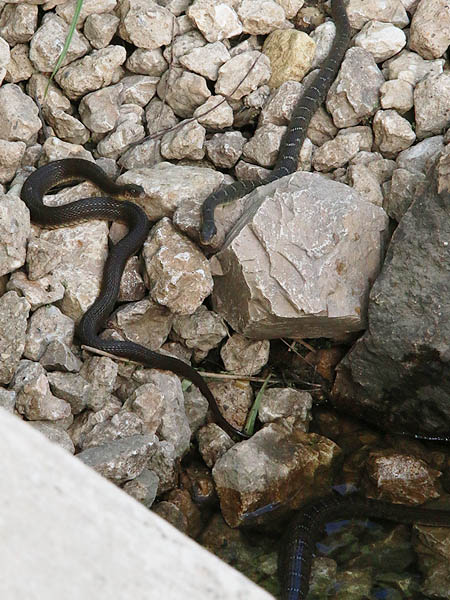




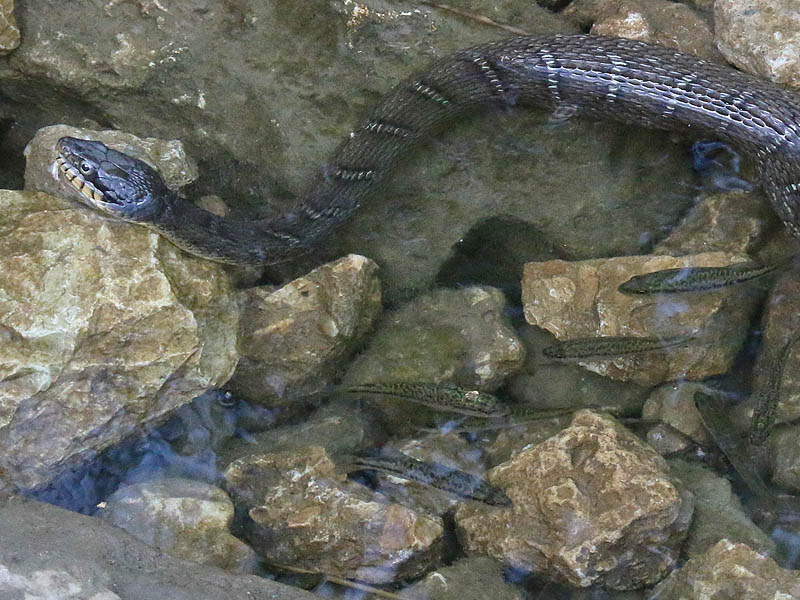


NOTE: This post is part of a continuing series of observations: [ First | << Prev | Next >> ]






